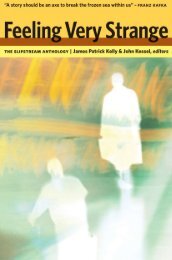The Curse of the Wer.. - Site de Thomas - Free
The Curse of the Wer.. - Site de Thomas - Free
The Curse of the Wer.. - Site de Thomas - Free
Create successful ePaper yourself
Turn your PDF publications into a flip-book with our unique Google optimized e-Paper software.
118 THE CURSE OF THE WEREWOLF<br />
a priest to perform <strong>the</strong> <strong>of</strong>fice <strong>of</strong> <strong>the</strong> <strong>de</strong>ad over her grave and <strong>the</strong> graves<br />
<strong>of</strong> her lycanthropic parents, <strong>the</strong>reby putting <strong>the</strong>m to rest. 10 Similarly,<br />
in Captain S.P. Meek’s ‘<strong>The</strong> <strong>Curse</strong> <strong>of</strong> <strong>the</strong> Valedi’ (1935), Valeska Valedi<br />
tells her would-be protector ‘Go, and remember, kill every wolf you<br />
find this night. Every one!’, knowing that she herself will be among<br />
<strong>the</strong> number killed. 11 Karen’s sacrifice in <strong>The</strong> Howling perpetuates this<br />
tradition; after being bitten, Karen arranges for a friend to shoot her<br />
with a silver bullet, but not before she has transformed into a werewolf<br />
in front <strong>of</strong> newsroom television cameras in or<strong>de</strong>r to warn o<strong>the</strong>rs about<br />
<strong>the</strong> existence <strong>of</strong> werewolves. Karen’s act <strong>of</strong> martyrdom reinforces entrenched<br />
cultural taboos against <strong>the</strong> expression <strong>of</strong> hedonistic pleasure<br />
and <strong>de</strong>sire by women, and her contrast with <strong>the</strong> sexually promiscuous<br />
werewolf Marsha links such apprehensions to <strong>the</strong> sexual liberation <strong>of</strong><br />
women in <strong>the</strong> 1960s and 1970s.<br />
A variation on <strong>the</strong> representation <strong>of</strong> <strong>the</strong> female werewolf as being<br />
at <strong>the</strong> mercy <strong>of</strong> un<strong>de</strong>niable physical urges was explored in Arlton<br />
Eadie’s ‘<strong>The</strong> Wolf-Girl <strong>of</strong> Josselin’ (1938), in which a Frenchwoman<br />
afflicted by a hereditary curse <strong>of</strong> lycanthropy marries an Englishman<br />
and bears his son. Soon, a wolf is observed on her husband’s estate<br />
and <strong>the</strong> men give chase as it carries <strong>of</strong>f <strong>the</strong> baby in its mouth. When<br />
<strong>the</strong>y discover <strong>the</strong> wolf, <strong>the</strong> narrator (<strong>the</strong> Englishman’s friend, and <strong>the</strong><br />
only person aware <strong>of</strong> <strong>the</strong> curse) sees immediately that ‘[m]o<strong>the</strong>r love,<br />
divine and all-conquering, had triumphed over <strong>the</strong> dread, age-old<br />
curse. <strong>The</strong> great, fierce she-wolf was actually suckling <strong>the</strong> babe it<br />
had been con<strong>de</strong>mned to <strong>de</strong>stroy!’ 12 Here, notions about <strong>the</strong> biological<br />
imperatives <strong>of</strong> maternity replace <strong>the</strong> focus on female sensuality, with<br />
<strong>the</strong> legendary maternity <strong>of</strong> <strong>the</strong> she-wolf (via <strong>the</strong> legend <strong>of</strong> Romulus and<br />
Remus and o<strong>the</strong>r stories <strong>of</strong> children raised by she-wolves) serving to<br />
draw <strong>the</strong> connection between women and nature. Although this story<br />
drew on entrenched i<strong>de</strong>als <strong>of</strong> maternal behaviour, its representation <strong>of</strong><br />
<strong>the</strong> female werewolf in a positive light marked <strong>the</strong> beginning <strong>of</strong> a shift<br />
that would become more pronounced during <strong>the</strong> twentieth century.<br />
In 1947, a story published in Weird Tales was <strong>the</strong> first account <strong>of</strong><br />
lycanthropy to portray a wolf becoming a human at <strong>the</strong> full moon<br />
ra<strong>the</strong>r than <strong>the</strong> o<strong>the</strong>r way around. <strong>The</strong> werewolf in Manly Banister’s





